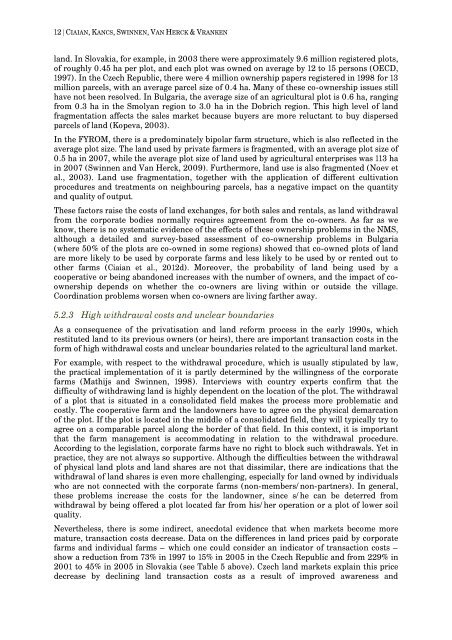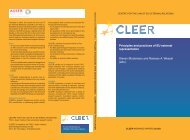Institutional Factors Affecting Agricultural Land Markets
Institutional Factors Affecting Agricultural Land Markets
Institutional Factors Affecting Agricultural Land Markets
You also want an ePaper? Increase the reach of your titles
YUMPU automatically turns print PDFs into web optimized ePapers that Google loves.
12 | CIAIAN, KANCS, SWINNEN, VAN HERCK & VRANKEN<br />
land. In Slovakia, for example, in 2003 there were approximately 9.6 million registered plots,<br />
of roughly 0.45 ha per plot, and each plot was owned on average by 12 to 15 persons (OECD,<br />
1997). In the Czech Republic, there were 4 million ownership papers registered in 1998 for 13<br />
million parcels, with an average parcel size of 0.4 ha. Many of these co-ownership issues still<br />
have not been resolved. In Bulgaria, the average size of an agricultural plot is 0.6 ha, ranging<br />
from 0.3 ha in the Smolyan region to 3.0 ha in the Dobrich region. This high level of land<br />
fragmentation affects the sales market because buyers are more reluctant to buy dispersed<br />
parcels of land (Kopeva, 2003).<br />
In the FYROM, there is a predominately bipolar farm structure, which is also reflected in the<br />
average plot size. The land used by private farmers is fragmented, with an average plot size of<br />
0.5 ha in 2007, while the average plot size of land used by agricultural enterprises was 113 ha<br />
in 2007 (Swinnen and Van Herck, 2009). Furthermore, land use is also fragmented (Noev et<br />
al., 2003). <strong>Land</strong> use fragmentation, together with the application of different cultivation<br />
procedures and treatments on neighbouring parcels, has a negative impact on the quantity<br />
and quality of output.<br />
These factors raise the costs of land exchanges, for both sales and rentals, as land withdrawal<br />
from the corporate bodies normally requires agreement from the co-owners. As far as we<br />
know, there is no systematic evidence of the effects of these ownership problems in the NMS,<br />
although a detailed and survey-based assessment of co-ownership problems in Bulgaria<br />
(where 50% of the plots are co-owned in some regions) showed that co-owned plots of land<br />
are more likely to be used by corporate farms and less likely to be used by or rented out to<br />
other farms (Ciaian et al., 2012d). Moreover, the probability of land being used by a<br />
cooperative or being abandoned increases with the number of owners, and the impact of coownership<br />
depends on whether the co-owners are living within or outside the village.<br />
Coordination problems worsen when co-owners are living farther away.<br />
5.2.3 High withdrawal costs and unclear boundaries<br />
As a consequence of the privatisation and land reform process in the early 1990s, which<br />
restituted land to its previous owners (or heirs), there are important transaction costs in the<br />
form of high withdrawal costs and unclear boundaries related to the agricultural land market.<br />
For example, with respect to the withdrawal procedure, which is usually stipulated by law,<br />
the practical implementation of it is partly determined by the willingness of the corporate<br />
farms (Mathijs and Swinnen, 1998). Interviews with country experts confirm that the<br />
difficulty of withdrawing land is highly dependent on the location of the plot. The withdrawal<br />
of a plot that is situated in a consolidated field makes the process more problematic and<br />
costly. The cooperative farm and the landowners have to agree on the physical demarcation<br />
of the plot. If the plot is located in the middle of a consolidated field, they will typically try to<br />
agree on a comparable parcel along the border of that field. In this context, it is important<br />
that the farm management is accommodating in relation to the withdrawal procedure.<br />
According to the legislation, corporate farms have no right to block such withdrawals. Yet in<br />
practice, they are not always so supportive. Although the difficulties between the withdrawal<br />
of physical land plots and land shares are not that dissimilar, there are indications that the<br />
withdrawal of land shares is even more challenging, especially for land owned by individuals<br />
who are not connected with the corporate farms (non-members/non-partners). In general,<br />
these problems increase the costs for the landowner, since s/he can be deterred from<br />
withdrawal by being offered a plot located far from his/her operation or a plot of lower soil<br />
quality.<br />
Nevertheless, there is some indirect, anecdotal evidence that when markets become more<br />
mature, transaction costs decrease. Data on the differences in land prices paid by corporate<br />
farms and individual farms – which one could consider an indicator of transaction costs –<br />
show a reduction from 73% in 1997 to 15% in 2005 in the Czech Republic and from 229% in<br />
2001 to 45% in 2005 in Slovakia (see Table 5 above). Czech land markets explain this price<br />
decrease by declining land transaction costs as a result of improved awareness and








